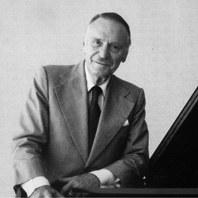Ponce, 1904 – San Juan (Porto Rico), 2003
By Angel G. Quintero Rivera
Luis A. Ferré Aguayo, governor of Puerto Rico between 1969 and 1973, was one of the most prominent Puerto Rican businessmen of the 20th century. A professional engineer, he was also recognized as a humanist: an avid pianist, art collector, and philanthropist.
His father, also an engineer, emigrated to Puerto Rico in 1896 from Cuba. He settled in Ponce, where he worked as a mechanic in sugar mills until, in 1918, he established the foundry Porto Rico Iron Works, which supplied or repaired parts for the mills. In 1901, he married the Puerto Rican Mary Aguayo Casals, from a prominent liberal family in Ponce.
Luis Ferré studied in the public schools of his hometown, pursued engineering at the Massachusetts Institute of Technology (MIT), and music at the New England Conservatory in Boston. His master’s thesis at MIT was about the use of sugarcane bagasse as energy and raw material for paper and cardboard production. In 1925, he began working at Porto Rico Iron Works, where he founded a workers’ cooperative, which was granted a share of the company’s profits. In 1931, he married Lorencita Ramírez de Arellano, from a family of sugarcane farmers. With her, he had two children, Antonio Luis, who led the main current newspaper in Puerto Rico, and Rosario Ferré, an internationally recognized writer.
In 1946, Luis Ferré purchased Ponce Cement from the government. With the developmental and urban boom of the 1950s and 1960s, Ponce Cement became one of the most important cement companies in the Caribbean. Ferré was considered the richest man in the country. Additionally, he bought and directed the local Ponce newspaper, El Día (1945–1969), which, as El Nuevo Día, moved to San Juan in 1970 under the leadership of his son. In his philanthropic work, prior to his election as governor, Luis Ferré founded the Ponce Public Library (1937), the Pontifical Catholic University (1948), the Ferré Foundation (1950), and the Ponce Museum of Art, which houses the most prestigious collection in the country—and one of the most comprehensive internationally—of European Pre-Raphaelite works (1956).
Considered the main “modern” pro-statehood leader, Luis Ferré saw statehood as a vehicle to improve the Puerto Rican economy and ensure its growth according to democratic ideals. He belonged to the Republican Statehood Party (PER), affiliated with the United States Republican Party, for which he was a candidate (defeated) for resident commissioner (1948) and governor (1956, 1960, and 1964). In 1952, he participated as a PER delegate in the Constituent Assembly that drafted the Constitution of the Commonwealth, and was elected to the new House of Representatives, where he advocated with the United States for an increase in the minimum wage for Puerto Rican workers.
Linked to the industrial phase of the sugar agroindustry, the Ferré family uniquely represented the transition of the local owning class: from agricultural capitalism to industrial capitalism and, later, very successfully, to the communication industry and flexible accumulation in recent decades. Luis Ferré distinguished himself as a supporter of internationalist humanist capitalism: a defender of the “great values of the West” and of “decent” treatment of workers, laying the foundations for “industrial peace,” especially by encouraging workers to become co-owners. In 1967, Luis Ferré broke with the PER and led the founding of the New Progressive Party (PNP), with which he won the gubernatorial elections. His administration sought to combine greater support for local businesses with the promotion of foreign investment in heavy industry. His most ambitious proposal—the Heritage for Progress—aimed to broaden the base of the owning sector to include many workers. He fought for industrial peace by raising wages and adding benefits during a period of intensified social struggles. His government faced more than seventy worker strikes and numerous land occupations or “rescues” for housing. Furthermore, he had to govern with a Senate controlled by the opposition party, the PPD, which, along with divisions within his own party and class—particularly regarding his plans for greater social justice—prevented him from advancing all his goals. In 1972, he lost to the PPD in his reelection bid. That year, he published the book The Human Purpose, which compiles his social and economic philosophy.
He returned to politics as a senator from 1976 to 1980 and subsequently remained quietly active as the great founding figure of the PNP until his death in 2003.



